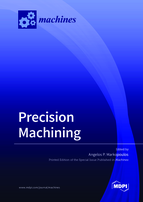Precision Machining
A special issue of Machines (ISSN 2075-1702).
Deadline for manuscript submissions: closed (28 February 2018) | Viewed by 62493
Special Issue Editor
Interests: manufacturing technology; machining processes; non-conventional machining; modeling and simulation
Special Issues, Collections and Topics in MDPI journals
Special Issue Information
Dear Colleagues,
Material removal processes are considered exceptionally important manufacturing methods used, worldwide, for the production of mechanical components. A key feature of these processes is their ability to produce final products with high accuracy and of high quality. Conventional and non-conventional machining, as well as abrasive processes, are vital for the production of high quality components from many different materials categories. Automotive, aerospace and medical industries are only some of the sectors that machined components of high dimensional accuracy, exceptional properties, complex sizes and usually from difficult-to-machine materials, are employed.
The research in the refinement of machining or the introduction of new features is ongoing and fast-growing. Precision machining on large scale components but in the micro- and nano-regime as well, concentrate the interest of the researchers. In the success of the research there are other aspects that need to be considered as the machine tools design and control, cutting tools, metrology and quality control, manufacturing systems and automation and of course modeling and simulation with various methods such as finite elements method, molecular dynamics and soft computing.
This Special Issue aims at attracting researchers to present recent advances and technologies in the aforementioned fields and indicate the future trends for precision machining.
Prof. Dr. Angelos P. Markopoulos
Guest Editor
Manuscript Submission Information
Manuscripts should be submitted online at www.mdpi.com by registering and logging in to this website. Once you are registered, click here to go to the submission form. Manuscripts can be submitted until the deadline. All submissions that pass pre-check are peer-reviewed. Accepted papers will be published continuously in the journal (as soon as accepted) and will be listed together on the special issue website. Research articles, review articles as well as short communications are invited. For planned papers, a title and short abstract (about 100 words) can be sent to the Editorial Office for announcement on this website.
Submitted manuscripts should not have been published previously, nor be under consideration for publication elsewhere (except conference proceedings papers). All manuscripts are thoroughly refereed through a single-blind peer-review process. A guide for authors and other relevant information for submission of manuscripts is available on the Instructions for Authors page. Machines is an international peer-reviewed open access monthly journal published by MDPI.
Please visit the Instructions for Authors page before submitting a manuscript. The Article Processing Charge (APC) for publication in this open access journal is 2400 CHF (Swiss Francs). Submitted papers should be well formatted and use good English. Authors may use MDPI's English editing service prior to publication or during author revisions.
Keywords
Precision machining
Micro- and nano- machining
Machine tools
Abrasive processes
Non-conventional machining
Modeling and simulation
Surface quality and integrity
Manufacturing systems
Precision engineering
Nanomaterials






